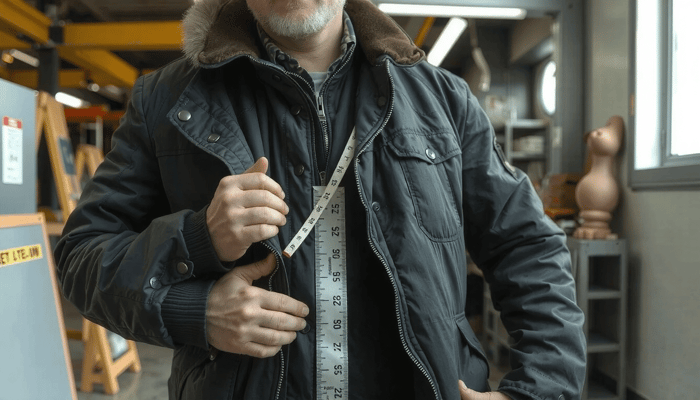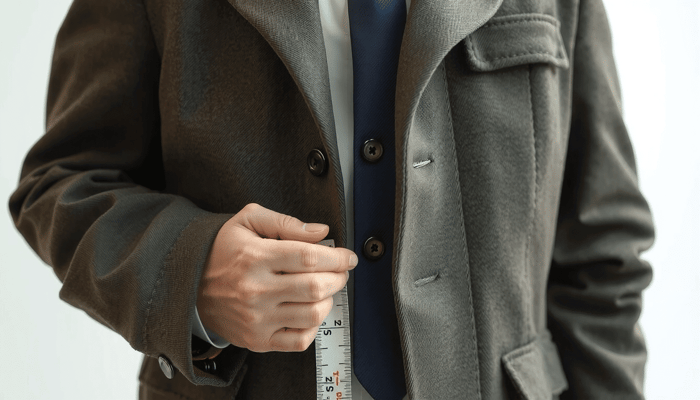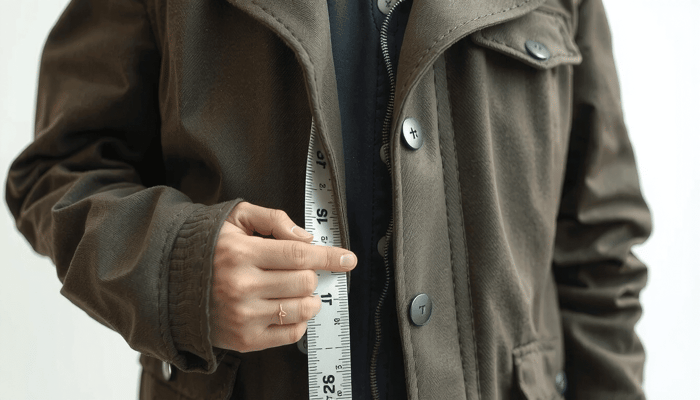The Ultimate Guide: How to Get a Jacket That Fits You Best
 Mr. Eton Yip | 32+ Year Garment Manufacturing Expert & Founder of Eton Garment
Garment Industry
Mr. Eton Yip | 32+ Year Garment Manufacturing Expert & Founder of Eton Garment
Garment Industry
July 22nd, 2025
11 minute read
Table of Contents
- Before You Start: What You'll Need
- Method 1: How to Measure Your Body for a Jacket
- Method 2: Measuring a Well-Fitting Jacket You Already Own
- Beyond the Numbers: Translating Your Measurements into the Perfect Size
- Jacket Style Nuances: Do I Measure Differently?
- Conclusion: Your Confidence in Fit
- Frequently Asked Questions (FAQ)
- FAQs
Shopping for a jacket online should be a fun, not a risky thing to do. We've all had that horrible feeling when the pack arrives, and the sleeves are shorter than your suitable fit or the chest is too tight. The endless cycle of returns is both annoying and expensive.
This guide is your personal roadmap through the valley of uncertainty. We'll share two proven ways that get you to the finish line of a perfect-fitting jacket every time. When you learn how to measure jacket size properly—first by measuring your own body, then by using a jacket you already love—you will just click "buy" without any doubt. Let's find you a jacket that is made just for you.

Before You Start: What You'll Need
When it comes to obtaining precise measurements, a few essential tools are needed. Having everything at your disposal beforehand means the process will be a lot easier and will eliminate mistakes. The right equipment is your first step in learning how to measure for a jacket.
Here's what you should gather:
- Essential Tool: A soft, flexible measuring tape (also called a tailor's tape). Rigid metal tape measures won't bend with your body's natural curves.
- Helpful: A friend to help with tricky measurements like shoulder width and sleeve length, which are hard to do alone.
- Optional: Pen and paper or your phone's notes app to record measurements as you take them.
- What to Wear: Thin, fitted clothing like a t-shirt and leggings. Thick items like sweaters or jeans will add unwanted inches and throw off your results.
Method 1: How to Measure Your Body for a Jacket
This fundamental approach allows you to understand your unique body shape. Taking your own measurements creates a universal set of numbers that can be used with any brand's size chart. It is the most reliable way to measure jacket size correctly from the start.
1. Chest/Bust Measurement
This one measurement determines the jacket size more than any other. A jacket that is either too tight or too loose in the chest area will always look and feel wrong.
Stand still and wrap the measuring tape around the fullest part of your chest or bust. Bring it under your armpits and across your shoulder blades. The tape has to be level with the floor and snug without restricting your breathing.
Pro-Tip: Breathe in and out in a normal way, then measure. Don't puff up your chest or hold your breath; this creates an inaccurate, oversized measurement.
2. Shoulder Width (Shoulder-to-Shoulder)
Proper shoulder fit is one of the most important factors, particularly with structured pieces like blazers and suit jackets. The shoulder seam should lay right on the shoulder bone for a clean, tailored look.
Ask a friend to measure across your back, from one shoulder's bony point (the acromion bone) to the other. Keep your posture natural with relaxed shoulders.
Pro-Tip: You can try measuring a well-fitting shirt if you are alone, but having a friend is definitely your best chance for a more accurate result.
3. Sleeve Length
Sleeve length can easily determine whether a jacket looks good or bad. Too short makes the jacket look ill-fitted, while too long gives it a messy look.
Stand with your arm relaxed at your side and bend the elbow slightly. Measure from the shoulder bone you previously located, down the outside of your arm, to the wrist bone.
Pro-Tip: That slight bend at the elbow is very important. Measuring with a completely straight arm could result in sleeves that ride up when you move.

4. Waist Measurement
For jackets with a fitted or defined shape, waist measurement ensures the jacket will not pull or bunch awkwardly.
Measure around your natural waistline—the narrowest part of your torso, usually about an inch above your belly button. Keep your stomach relaxed; do not suck in.
Pro-Tip: Find your natural waist by bending sideways. The crease that forms will mark your natural waistline.
5. Jacket Length
This measurement reflects your personal preferences and taste. It determines where the jacket's hem will sit on your body.
Standing straight, measure from the prominent bone at the back of your neck down to where you want the jacket to end. This might be at your hip for a bomber, mid-thigh for a field coat, or lower for a formal overcoat. For formal wear, specific measurement points are essential, and you can find excellent guidance for tailored jackets to ensure proper draping.
Method 2: Measuring a Well-Fitting Jacket You Already Own
If you have a jacket that fits perfectly, use it as your reference point. This method works as a great shortcut, especially when online stores list "garment measurements" on their product pages, because it enables you to make direct comparisons.
Step 1: Lay the Jacket Flat
First, make sure the jacket is buttoned or zipped completely. Lay it on a flat surface like a table or a clean floor. Be sure to smooth out any wrinkles or bunching so the garment lies as flat as possible.
Step 2: Measure Chest (Pit-to-Pit)
With the jacket flat, measure straight across from one armpit seam to the other. Double this number to get the full chest circumference of the garment. This is one of the most common and useful measurements brands provide.
Step 3: Measure Shoulder, Sleeve, and Length
Take the other key measurements directly from the garment itself.
- Shoulder: Measure across the back from the top of one shoulder seam to the other.
- Sleeve: Measure from the top shoulder seam down the outside of the sleeve to the end of the cuff.
- Length: Flip the jacket over and measure down the center of the back, from the base of the collar seam to the bottom hem.
Visuals are helpful for this process, and you can refer to this detailed visual guide that walks through each garment step.
Beyond the Numbers: Translating Your Measurements into the Perfect Size
Getting your numbers is only half the battle. Now, you need to convert them into the correct size choice. This can be confusing for many shoppers, but understanding the key concepts will help you navigate online stores and master how to measure jacket size effectively.
Understanding Sizing Systems: Numeric vs. Alpha
You will notice two main sizing types: Numeric (like 38, 40, 42) and Alpha (S, M, L).
Numeric sizing, which is common in men's suit jackets and blazers, usually matches your chest measurement in inches directly. A size "40R" would typically fit someone with a 40-inch chest.
Alpha sizing (Small, Medium, Large) covers ranges. A "Medium" might fit chest sizes from 38 to 40 inches. This explains why Alpha sizes vary dramatically between brands.
How to Read a Brand's Size Chart
Here's a golden rule for online shopping: always check the specific brand’s size chart on the product page. Don’t ever assume a “Medium” means the same thing everywhere.

Size charts might show "Body Measurements" or "Garment Measurements."
- Body Measurements indicate what size person the garment is designed to fit. Match your measurements to these.
- Garment Measurements give the jacket's actual dimensions. Use your Method 2 measurements for comparison.
Looking at brand size charts like this one shows how they often provide both options, giving you two ways to confirm your size.
The Importance of "Fit": Slim, Regular, and Relaxed
Two "Medium" jackets can fit very differently because of their intended style. This depends on "ease"—the extra space that designers build into a garment for comfort, movement, and style.
- Slim Fit: Has very little ease. It sits close to the body for a sharp, modern look. If your measurements are at the upper end of a size range, you might need to size up in a slim fit.
- Regular/Classic Fit: This is the standard. It has a moderate amount of ease, allowing for comfortable movement and light layering underneath.
- Relaxed/Oversized Fit: Features generous ease for a loose, contemporary style. You can often choose your standard size and still achieve the intended baggy look.
Jacket Style Nuances: Do I Measure Differently?
![]()
Yes, the type of jacket you are buying can change which measurement you should prioritize. Adopting a new strategy based on the style is an expert move that will ensure a better fit.
For Structured Jackets (Blazers, Suit Jackets)
Focus on shoulder width and chest measurement. A perfect shoulder fit is essential since it is the hardest and most expensive part to alter. The jacket should button comfortably without pulling in the chest.
For Leather & Denim Jackets
Focus on chest and sleeve length. These jackets should fit snugly at first. Quality leather and denim will stretch and form to your body over time, so starting with a close fit is best.
For Bomber & Casual Jackets
Focus on jacket length and your overall fit preference. The shoulders on these styles are often less structured (sometimes called "drop shoulders"), giving you more flexibility. The key is choosing your preferred length and deciding between a classic or relaxed style.
For Puffer & Down Jackets
Focus on the chest measurement, considering your layering needs. The insulation adds bulk already. Think about what you will wear underneath; if it includes thick hoodies or sweaters, consider going one size up for adequate room.
Conclusion: Your Confidence in Fit
Mastering how to measure jacket size transforms your online shopping experience. You are no longer guessing but making informed decisions based on data. The frustration of wrongly fitted clothes and return hassles can be a thing of the past.
Save your measurements in your phone's notes. They are your personal key to unlocking perfectly fitting outerwear. Following these steps will equip you to find an excellent off-the-rack fit. For those seeking a truly bespoke or custom-tailored experience for unique body types or specific style needs, exploring professional garment services from specialists like Eton Garment can provide that perfect, made-for-you solution.
Frequently Asked Questions (FAQ)
1. What if my measurements fall between two sizes?
Check the product description for any fit notes (like "runs small" or "slim fit"). For a tighter, more tailored look, consider the smaller size. For comfort or layering plans, sizing up is safer. Tailors can easily take in a slightly oversized jacket, but they can't add fabric that isn't there.
2. How do men's and women's jacket sizes differ?
They are fundamentally different. Women's jackets are designed to accommodate a bust and hips, often featuring a tapered waist. Men's jackets are cut straighter through the body and are primarily designed based on chest circumference and shoulder width. Always use the brand's gender-specific size chart.
3. Do I need to add extra inches for a comfortable fit?
Generally, no. Brands already include "ease" (extra room for movement and style) into their sizing. Measure your actual body and trust the brand's size chart. Only consider sizing up if you know you'll wear exceptionally thick layers under a slim-fitting jacket.
4. Is the chest measurement the same as my suit jacket size?
Yes, in most cases they're directly related. A men's suit jacket size like "42R" is made to fit a 42-inch chest. The letter indicates length: 'S' for Short, 'R' for Regular, and 'L' for Long, corresponding to your height and arm length.
5. Can I just use my t-shirt size (S, M, L) for a jacket?
We strongly advise against this. T-shirt sizing varies wildly between brands, and the fit is much more forgiving. Jackets are structured garments where fit is crucial. Taking a few minutes to measure is the only reliable way to learn how to measure jacket size properly and ensure you get a product you'll love. For further questions about garment construction or custom needs, the experts at Eton Garment are a valuable resource.
Related Articles
What is a Bomber Jacket? The Ultimate Guide to Fashion's Classic Piece
9 minute read
July 22nd, 2025
A bomber jacket is a short, waist-length outerwear piece. It has a zipper in the front, a defined... more »
Your Complete DIY Guide to Fixing a Jacket Zipper: From Getting Stuck to Replacing It
11 minute read
July 22nd, 2025
A malfunctioning zipper on your go-to jacket is a common cause of irritation. Such issues are common.... more »
A Barbour Jacket Is a Definitive British Element! The Complete Guide to This Icon
10 minute read
July 22nd, 2025
A Barbour jacket symbolizes the British identity. It is precisely made as it is outerwear made... more »
Today's Jacket Dilemma: How to Make the Right Choice
5 minute read
July 22nd, 2025
Every day we wake up and face the same scenario. Check out the weather. Look at the closet. Ask... more »
Chic & Warm: The Perfect Combinations Between Jacket and Formal Dress
10 minute read
July 21st, 2025
Finding a beautiful formal dress is like scoring a winning goal. However, the next step is the challenging... more »

